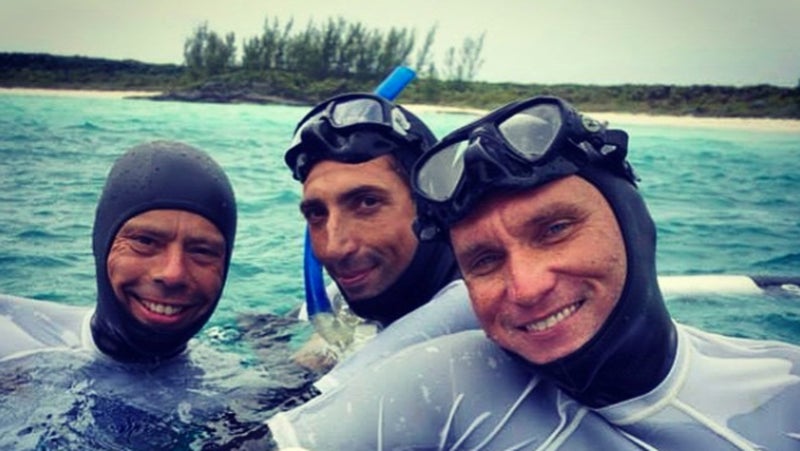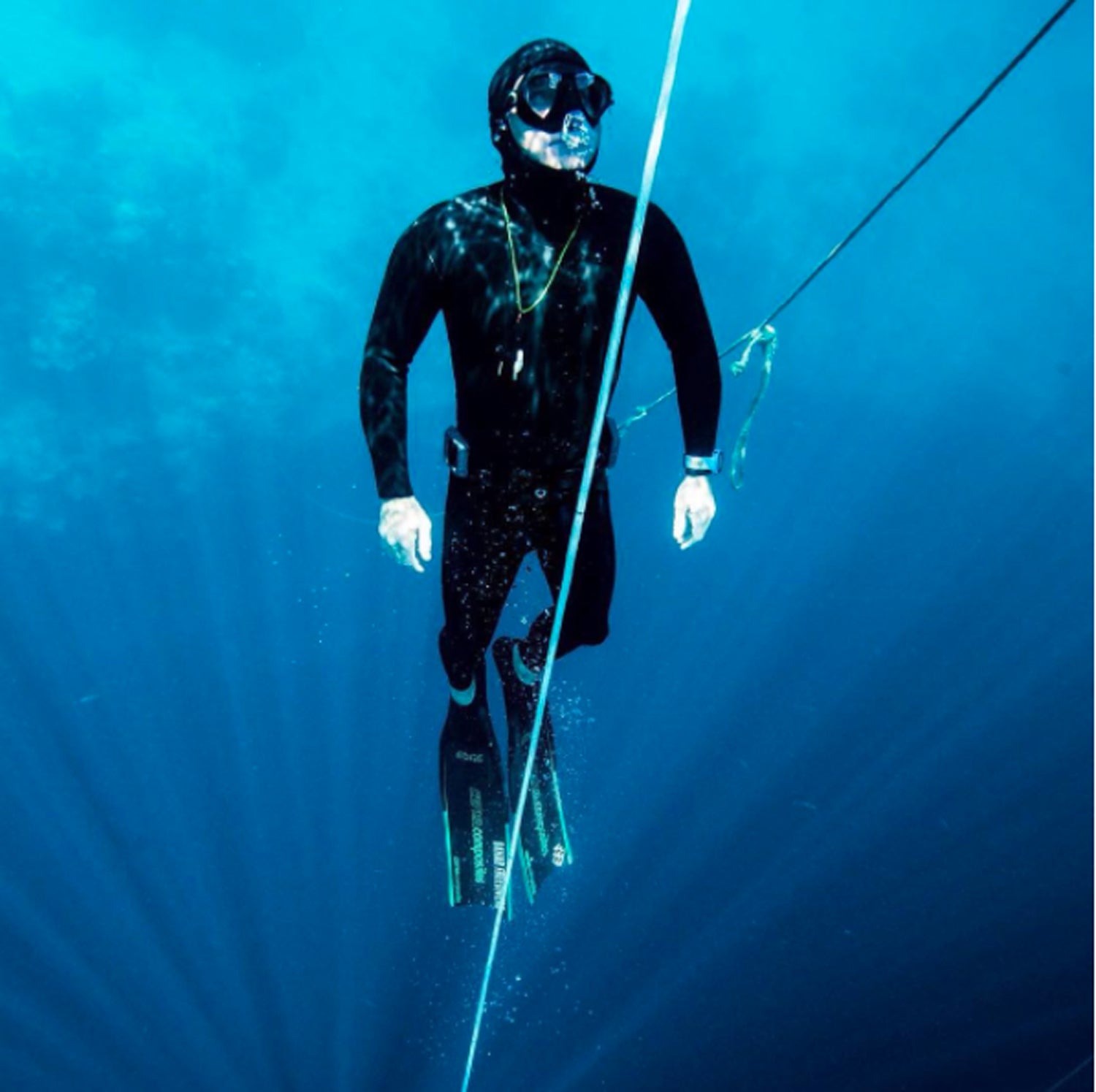����������Ի�’s , freediving’s most accomplished and beloved safety diver, died July 22 from in the Blue Hole, a diving spot in the Red Sea off the coast of Dahab, Egypt. During an epic rescue, he was attempting to assist freediver to the surface from a depth of 50 meters. His was the first recorded death of a safety diver in action in freediving history.
Conditions weren’t ideal in the Egyptian dive mecca on Saturday. Visibility wasn’t good, and the winds were high enough—20 miles per hour—that they were pushing the water around, conjuring currents that could push a freediver off course, especially one who was aiming to traverse the Arch, an 85-foot-long redrock tunnel set 184 feet deep, on a single breath.
It’s one of the more dangerous recreational dives in the sport, but if any woman in the world could do it, it would be Alessia Zecchini of Italy, who for depth achieved on a single breath with a dive of 104 meters (341 feet) last May at the , considered the Wimbledon of freediving. On this day, Zecchini appeared to have been attempting to swim through the length of the Arch and back to the surface without fins, using a modified breast stroke rather than a more-powerful monofin. For safety, she made sure Keenan was tailing her in case anything went wrong.
“What troubles me most is that this can happen because maybe the attention is on the athlete ‘in trouble.’ No one notices the safety diver.”

Keenan was by Zecchini’s side when she snagged her world record last May, which wasn’t all that unusual. He was an icon of the freediving community. If you glimpse recent photographs of freedivers enjoying the foamy celebrations that erupt in record-breaking reverie, Keenan is almost always there. Born and raised near Dublin, Ireland, Keenan fell in love with the sport that would become his life while vacationing in Dahab in 2009. Within a few years, he would relocate there, learn Arabic, become a freediving instructor, and train hundreds of students in Egypt, Spain, and the Philippines. In 2015, Keenan founded with Spain’s , one of the deepest freedivers on earth, and Swiss freediver . That year, Keenan would record his career-best dive with a monofin to 81 meters (267 feet)—well beyond the range of most scuba divers.
But Keening really made his name as a safety diver. Freediving competitions are impossible to pull off without the work of a dedicated team of four to five safety divers. Diving is rarely the problem—it’s the ascent. As competitors try to resurface after being submerged for more than two minutes, the partial pressure of oxygen begins to plummet in their bloodstream, putting them at risk for a blackout.
Typically, the deep safety diver will meet a diver at 30 meters (100 feet), with a second safety joining them at 20 meters (66 feet), and a third at ten meters (33 feet). Then, the four will swim to the surface together. Along the way, a safety watches for signs that a diver may be fading and on the verge of a blackout. If the diver does lose consciousness, one or more of the safeties will cover the diver’s nose and mouth—so they don’t get water in their lungs—and ferry them to the surface, where they will revive the diver, usually by blowing on their eyelids and calling their name. If necessary, mouth-to-mouth rescue breaths are employed, and if emergency techniques are implemented correctly, the athlete should come around. Which is why, for all the sport’s perceived danger, there has only ever been one competition fatality: on November 17, 2013, when after a dive in Dean’s Blue Hole at Vertical Blue.
On Saturday, according to multiple sources, Zecchini descended to the mouth of the Arch along a line as planned but became disoriented at depth. Keenan bolted to her aid at a reported 50 meters (164 feet) and began finning her to the surface. Zecchini made it back unscathed, but Keenan blacked out underwater at a depth that remains unknown. He was found floating on the surface, face down and unresponsive. Despite repeated attempts to save his life, he could not be revived.
Keenan’s loss left a void in the freediving community, and an outpouring of emotion surfaced on Facebook all weekend. Athletes, freediving professionals, his students, and neighbors shared their own private moments with Keenan, who was usually grinning ear to ear.
In an online tribute, freediving photographer called Keenan “our best safety diver.”
“You knew he had your back,” says Dr. Kerry Hollowell, an emergency room doc and competitive freediver on the U.S. National Team. “He would not bail on you.”
“He was the heart of the community,” says , who holds the (425 feet). Molchanov witnessed Keenan’s commitment firsthand on his failed 2013 world-record attempt to dive 128 meters (419 feet) in Kalamata, Greece. Molchanov’s inner ear became clogged, and the air he used to equalize his sinuses couldn’t escape, causing vertigo on the ascent. “I remember feeling dizzy and was ascending at half my usual speed,” Molchanov says. Meanwhile, Keenan was suspended at 32 meters (104 feet), searching the limitless blue for more than 40 seconds, his own urge to breathe building.
“I had that horrible situation that a safety always hates,” Keenan told me in 2014 for my book . “You can’t just stay there indefinitely, but you don’t want to leave your man.” When a struggling Molchanov finally came into view, obviously disoriented, he finned down to 40 meters (131 feet). Despite being four inches shorter and 30 pounds lighter, he began swimming Molchanov to the surface. It was a heroic and selfless move. “He waited for me much longer than he should have,” Molchanov says, “but that’s how he was.”
With Keenan’s passing, some are calling for a renewed focus on the well-being of safety divers. “What troubles me most is that this can happen because maybe the attention is on the athlete ‘in trouble,’” says UK record holder . “No one notices the safety diver.”
“Safety diving has always been in the background, and this event will increase vigilance and help us improve safety measures for safety divers, because they can black out too,” Hollowell says. “It also reminds us that no matter how many records or how much experience you have, nobody is immune to death by freediving. That will always be the case for anyone who enters the water, forever.”


